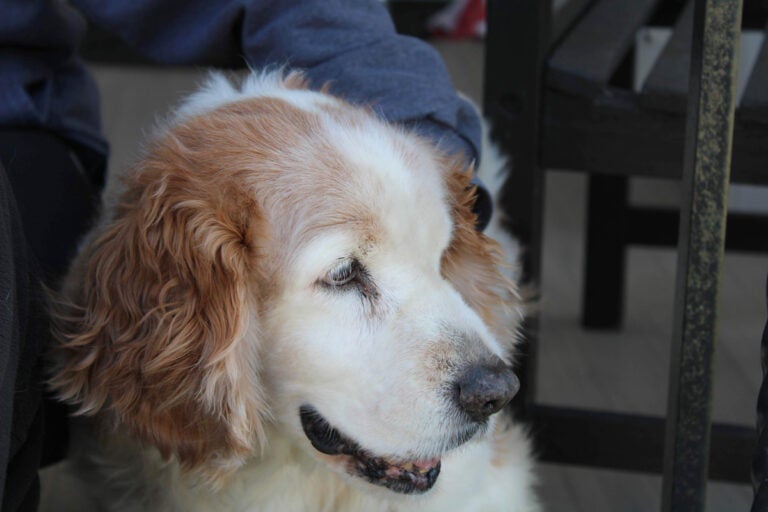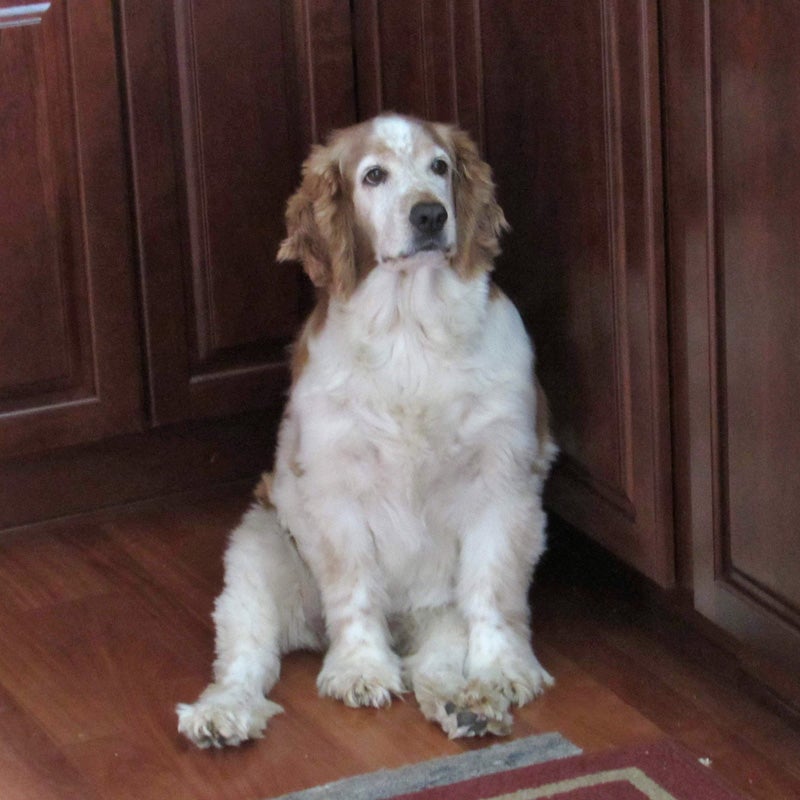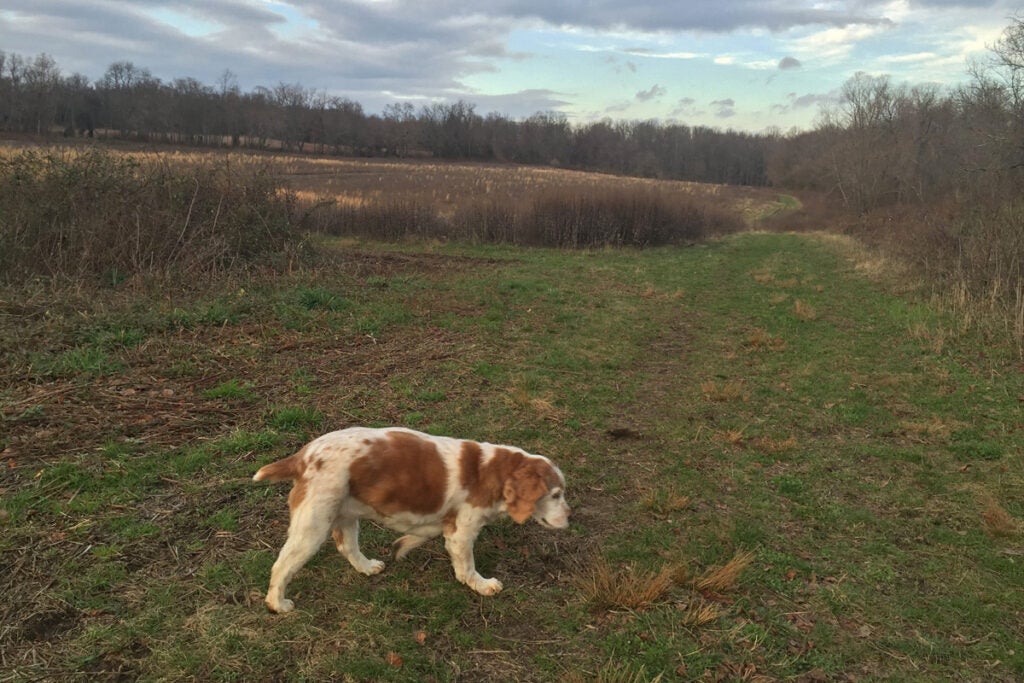The long, sad process of saying goodbye to a pet
Bidding a beloved animal farewell is hard. Knowing when it’s time can be even harder.
Listen 8:27
Emma, a Welsh Springer Spaniel. Bidding a beloved animal farewell is hard. Knowing when it’s time can be even harder. (Courtesy of Grant Hill)
This story is from The Pulse, a weekly health and science podcast.
Subscribe on Apple Podcasts, Stitcher or wherever you get your podcasts.
The saddest thing about growing up is discovering those magical places that filled so much of your imagination as a kid — really aren’t so magical.
Perhaps the final frontier of these depressing destinations is The Farm.
You know, The Farm. The place where your parents told you your childhood pets went to live happily ever after with all the other animals. The Farm from which there is no return.
Well, obviously, The Farm is not a farm at all. In a small building at the end of a long driveway lined with gravestones etched with names like “Lucky” and “Buttons,” Meghan Cianci frequently guides grieving pet owners into a room painted in calming colors. There, a large window is cut out from an interior wall, allowing them to peer through at a capacious metal box that looks like something a train conductor might shovel coal into.
When Cianci showed me the room, a fuzzy purple blanket covered something lumpy and stiff on a table in front of us.
“For a lot of people, pets are their fur babies,” she said. “There’s a lot of people that don’t have children, they have pets.”
Cianci is a bereavement counselor at a pet funeral home, crematorium and cemetery in central New Jersey. She said a surprising number of pet owners elect to watch their deceased animals enter the cremator. The process is supposed to help provide closure.
During her time at the crematorium, Cianci said, she has helped countless people get through the loss of their pets.
“It doesn’t really matter what kind of pet it is. Like, I mean, we have burials of turtles … in like a coffin and everything else, and we had a viewing for them.” It’s not uncommon for pet owners to have priests or rabbis preside over the ceremonies, she said.
“We offer prayers, poems, whatever they need to help get through this process,” she said.
On the day I was at the crematorium, Cianci was helping another pet owner: me. Underneath that purple blanket was my dog, Emma.

My family got Emma when I was in fourth grade. I’d been begging my parents for a dog for too long, when they finally budged.
“At the time, Dad and I were both working, and we didn’t want you or your brother to come into an empty home,” said my mom, Iris Hill.
My parents set very strict terms when the dog first arrived at our home. Emma was to be my responsibility, so I had to do all the dirty work. Of course, it never quite works that way. Still, my older brother and I were made to sign a contract ensuring we would look after her. From then on, Emma, a small Welsh Springer Spaniel, reigned over our house.
Through the years, our dog never quite grew into the over-affectionate greeter my mom imagined. Emma was sort of regal, a little standoffish even. She was the kind of dog that would sit just far enough away from you that you really had to make an effort to pet her. So whenever Emma let her guard down to rub her snout on your leg or gently lick your toes, it felt special. Like she secretly loved you the most.
Subscribe to The Pulse
Emma was 94 in dog years when she died. At the end, it was hard to remember a time when her dark red and white fur wasn’t all faded and bristled.
One day she randomly came in from the backyard with a limp. She would never really walk straight again. She wasn’t exactly sick, just old.
During the last year of her life, everything, even just breathing, was clearly a struggle for her.

She became “The Troll Downstairs.” Her inability to climb steps turned the kitchen into her territory, and she would let you know by sluggishly pacing and snorting until you let her lick your plate after dinner.
Then she started to pee all over the house, looking confused, eyes glazed over like she didn’t know if she was inside or out. To us, it seemed as if she felt bad about her accidents.
“You know, I think we kind of knew that it would progressively get worse. And the medication did help for a little bit. We tried the doggie diapers. We tried a lot of different things,” my mom said.
We blocked off whole sections of our house with painter’s tape to prevent accidents in high-risk areas. That’s all it took to prevent Emma from maneuvering into a room with furniture.
We hosed down countless rugs and started buying Formula 409 in bulk.
All that might seem crazy if you don’t actually own a pet.
“I see some people go through heroics that don’t necessarily benefit the patient.” said Mike Petranto, my uncle, who is a veterinarian.
My family consulted my uncle regularly during Emma’s decline. He wasn’t surprised at our efforts to keep her with us, as he’s seen many clients go to extremes to keep their pets alive.
“There are some types of cancers that dogs, cats get that we can say, no matter what’s done, it doesn’t really buy … good quality time. And I will say that people who have elected to treat those cancers, maybe chemo or whatever, most of them do regret putting the animals through that for three months,” Petranto said.
That’s because more good quality time is markedly different from just more time. My family struggled with that. We saw Emma was suffering, but we couldn’t bring ourselves to let her go.
“The decision weighed on me a lot,” my mom said. “I found myself really kind of depressed about it. Because, you know, it wasn’t a decision I really wanted to make. I would just pray that the Lord would take her and I wouldn’t have to make that decision. But obviously, that didn’t happen.”
Even in old age, Emma was still way too stubborn to make anything easy on us. We had to set a date, and we did. But the decisions didn’t end there. What followed after was a bizarre menu of grim choices.
Would she be more comfortable at home for the procedure? Or would that make her feel like we were tricking her somehow? Did we all want to be there for her during it? Or would watching it be too traumatic for us? The forecast looked beautiful for the coming week, should we let her have a few more days of gorgeous weather?
Then, finally, the day came. There was no more time for questions as my uncle made his way to our home with his kit.
“I remember trying to be outside with her until he got there, because, I don’t know, I just wanted her to be able to be outside, you know.” my mom said, teary-eyed. “And we had pizza, and she got to have our pizza crust. It was like we were all home for her. It was very difficult to see her go. But we can’t be selfish.”

Two weeks later, my uncle personally brought Emma over from his office, where he keeps the bodies of his clients’ deceased animals in a big freezer before they can be processed. My uncle and I watched as an employee lifted the purple blanket to prepare Emma for the last leg of her long journey home to The Farm.
To my surprise, she didn’t look cold or anything. For the first time in a long time, she didn’t look uncomfortable at all.
Cianci, the bereavement counselor, reassured me that it’s common for owners to witness a pet’s body go into the cremator, to ensure the cremains they ultimately receive are really their pets. But I didn’t have to. I nodded.
They asked me if I was ready. I wasn’t, but I find a little comfort knowing no one ever really is.
WHYY is your source for fact-based, in-depth journalism and information. As a nonprofit organization, we rely on financial support from readers like you. Please give today.






